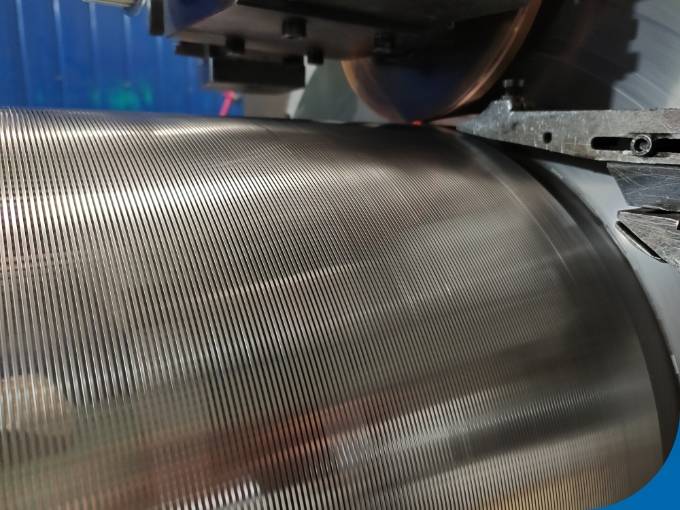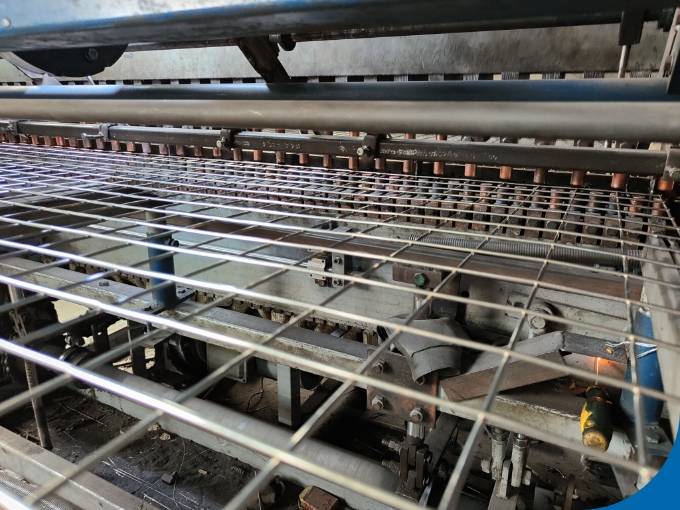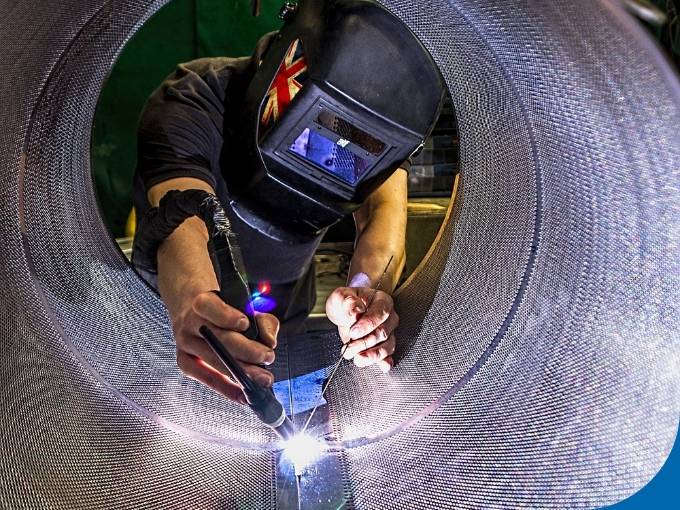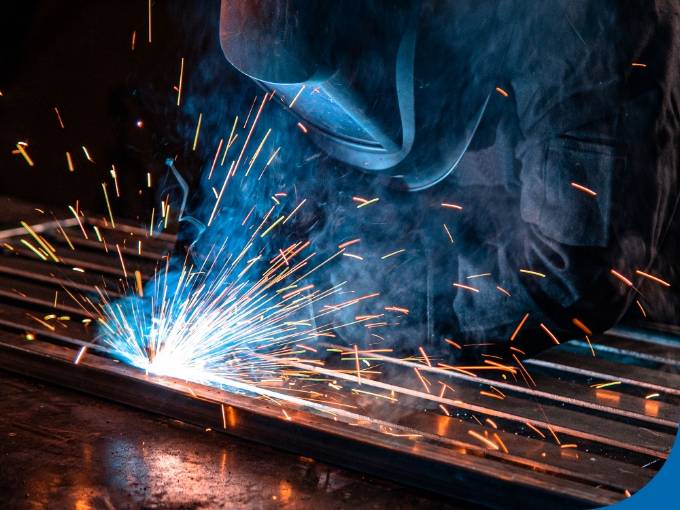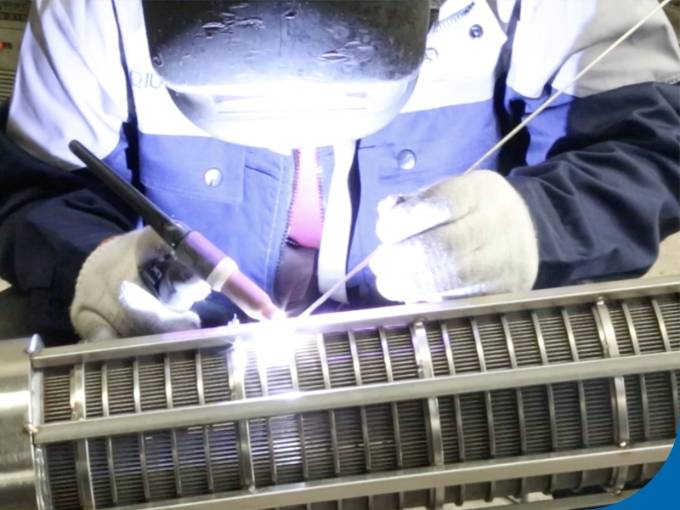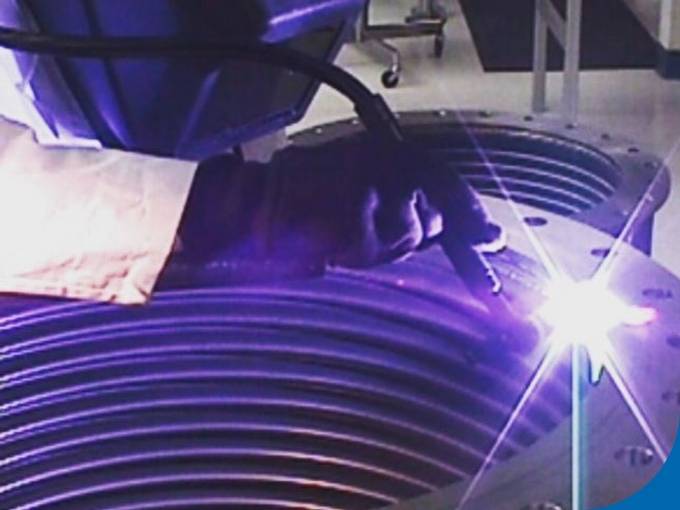Resistance welding for wedge wire screen
- Home
- Products
- Perforated Metal Products
- Metal grating
- Wedge Wire Screens
- Wedge Wire Slot Tubes
- Wedge Wire Strainer Elements
- Flat Wedge Wire Screen Panels
- Sieving Bending Wedge Wire Screen
- Pressure Arc Screen for Starch
- Wedge Wire Grates
- Intake Screens
- Vessel Lateral Assembly
- Resin Trap Screen
- Filter Nozzle
- Wedge Wire Screen Cylinder
- Screw Press Screen
- Rotary Drum Screen
- Pressure Screen Drum
- Metal Wire Mesh
- PU Screen
- Industry
- Fabrications
- Service
- Technology
- Safety Grating Walkway
- Safety Grating Stair Tread
- Safe Grating Ladder Rung
- Safety Grating Scaffolding Plank
- Perforated Metal Vibrating Screen for Mining Screening
- Brick Plant Vibrating Screen
- Brewery Mash Tun Floors
- Sugar Industry
- Grains Industry
- Paper Making Industry
- Pipe Schedule Chart
- Metal Wire Gauge Chart
- Metal plates gauge chart
- What are the advantages of CNC punching?
- What Are Benefits of Surface Sandblast of Drilling Screen Plate?
- Comparison of Various Intake Screens
- Why Choose Wedge Wire Screen For Brewery Mash Tun False Bottom?
- Why Twin Screw Press Machine prefer to drilling plates?
- DSM Screen Improves Processing Efficiency
- What Is the Difference for PVDF Coating and Powder Coating?
- Inspection and Test Equipment for Checking Weaving Metal Wire Cloth
- How To Calculate the Stainless Steel Welded Wire Mesh Weight?
- Construction Types Flowing Direction Wedge Wire Screen Tube
- What Are the General Types of Wire Mesh Filter Elements and Strainers?
- Inspection and Test Equipment for Checking Perforated Metal
- What Materials Grade for Woven Wire Mesh and Cloth?
- How Many Edge Types of the Stainless Steel Welding Wire Mesh Panels?
- What Is Difference Between the Opening and Mesh for Welding Wire Mesh?
- What Holes Pattern Perforated Metal Anti-Slips Safety Gratings We Can Make?
- Wedge Wire Screen Highly Improving Sugar Manufacturing Efficiency
- Quick and Easy Reference Data and Order Tips for Stainless Steel Wire Cloth
- What’s The Difference Between Perforated Metal Tube And Perforated Metal Pipes?
- How to Choose Stainless Steel Material Grade for Your Metal Wire Mesh Products?
- How to Choose Metal Wire Mesh?
- Stainless Steel Wire Mesh/Wire Cloth Reference Data and Order Tips
- How to Calculate the Stainless Steel Wire Mesh Weight?
- Calculators
- Download
- RFQ Forms
- Technology
- Case Studies
- Industry Filtering Wire Cloth
- 100 Mesh Stainless Steel Wire Mesh
- SS310 Stainless Steel Woven Wire Cloth
- 50 mesh Stainless Steel Woven Wire Cloth
- 3 mesh Selvage Edge Woven Wire Mesh
- 325 × 2300 mesh Dutch weave wire mesh cloth filter
- 260 × 40 mesh
- 132 × 17 mesh
- Filter Wire Cloth
- 8mesh Selvage Stainless Steel Wire Mesh
- 6mesh stainless steel wire mesh
- 4mesh×0.8mm wires stainless steel wire mesh
- 3×3mesh Selvage Stainless Steel Wire Mesh
- 60mesh×0.15mm Wire Cloth Belt
- 310 40 mesh × 0.25 mm Wire Cloth
- Reverse Dutch Wire Cloth Belt
- 4×4mesh Selvage Stainless Steel Wire Cloth
- 12×64mesh Plain Dutch Weave wire mesh
- Stainless Steel Wire Mesh Filter Disc
- Wedge Wire Screen Filters
- 0.1 & 0.3 mm Slot Wedge Wire Filter Elements
- SS304 Wedge Wire Screen Cylinder
- SS304 Wedge Wire Screen Water Distributor
- SS304 Wedge Wire Intake Screen
- SS316 Wedge Wire Filter Nozzle
- 6 Inch FNPT Wedge Wire Slot Tubes
- BSPT Thread Wedge Wire Screen Filter Elements
- Duplex 2205 Wedge Wire Screen Strainer
- SS304 Flat Wedge Wire Screen Panels
- SS316 Wedge Wire Screen Panel
- T-Type Intake Screen
- Wedge Wire Screen Lower Distributor
- Wedge Wire Header Lateral Assemblies
- S32750 Wedge Wire Screen Cylinder
- SS316L Wedge Wire Screen Cylinder
- SS304 Wedge Wire Screen Cylinders
- SS304 Screw Press Separator
- Round Support Rod Wedge Wire Screen Panels
- 80 Micron Wedge Wire Screen Tube
- Drum-Type Intake Screen
- Wedge Wire Screen with Frame
- SS304 Sieve Bend Screen
- SS304 Wedge Wire Filter Screen
- Duplex 2205 Wedge Wire Screen Tube
- Hastelloy C276 wedge wire screen tube with Corrosion Resistance
- 1'' #150 BSPT Wedge Wire Screen Filter Laterals
- 3/4" NPT Threaded Nozzle with Efficient Filtration
- Wedge Wire Lateral Assemblies with High strength and rigidity
- M45x2.0 FOTI 0.2mm Slot Wedge Wire Screens
- O.D. 54 mm Wedge Wire Screen Tube
- Vibration Wedge Wire Screen Panel
- Sewage Treatment DSM Screens
- Wedge Wire Screen Panel for American down jacket company
- 120 Degrees 50 Microns DSM Screen For Starch Screening
- Thread Joint Wedge Wire Screen Water Distributor Inside Vessel
- Wedge Wire Screens With 33 MM Outer Diameter
- Flat Screen With Rectangular Support Rods
- Wedge Wire Intake Screen as Safeguard for Intake System
- 1 Inch NPT Wedge Wire Screen Nozzle
- Wedge Wire Filter Cartridge for Ballast Water Treatment Systems
- Duplex 2507 small intake screen
- 20 microns wedge wire screen filter
- Flat Plate Double Flow Rating Filter Nozzle for Filtration Tank
- Wedge wire screen basket
- Screw Press Separator Wedge Wire Screens for Agricultural Branch
- Wedge Wire Screen Grid for Beer Factory
- Wedge Wire Screen Tube for Water Pump Project
- Wedge Wire Filter Screen Segments for Chemical Plant
- Resin Trap Screen for ion Exchange & Other Media Filter Systems
- Wedge Wire Screen Laterals for Water Treatment System
- Wedge Wire Screen Filter Nozzle for Water Distribution System
- Wedge Wire Screen Tube for Welding and Machining Company
- DSM Screen for Sugar Making
- Wedge Wire Screen Nozzle For Fertilizer Plant
- 120° Static Starch DSM Screen
- Wedge Wire Drip Tray
- Wedge Wire Screen Distributors and Resin Trap
- SS304 Wedge Wire Screen Laterals
- 0.4mm Slots Wedge Wire Screen Flat Panels
- Wedge Wire Screen Scrubber
- Wedge Wire Screen Water Distributor
- Industry Perforated Metal
- SS304 & MONEL Welded Perforated Metal Tubes
- 18.8% Open Rate Perforated Metal Disc Filters
- 316L Stainless Steel Perforated Tube
- Height 86.9 mm Conical Filter Cartridge
- SS316 Fan-shaped Perforated Plates
- Laser Perforated Plate for Centrifuge Screen
- Custom Stainless Steel Filter Basket
- Q235B Mild Steel Metal Perforated Plate
- SS304 Bending Perforated Plate
- 150 mm O.D. Drilling Perforated Metal Disc
- Laser Square Perforated Plate
- Laser Drilling Micro Perforated Disc
- 0.6 mm Laser Drilling Perforated Metal Cylinder
- 0.3 mm Laser Micro-Perforation Plate
- 0.15 mm Laser Cutting Perforated Metal Ring
- 0.1 mm Laser Micro-Perforation Plate
- Round Hole Perforated Mesh Screen
- Micro Hole Perforated Metal for Twin Roll Press
- Perforated Tube Filter Element
- Drilling perforated metal cylinder with reinforced support, 2mm thickness
- Stainless steel 304 micro drilled metal filter cylinder device
- 6mm thick drilling Perforated Metal Disc
- 0.5mm Hole Diameter Perforated Plate
- 0.4 mm micro perforated mesh for coffee filtering
- Drilling Perforated Dewatering Backing Plate
- Perforated Filter Disc
- Perforated Metal Mesh Cylinder
- Drilling Perforated Metal Plate For Iran Petrochemical Industry
- SS316 0.5mm diameter micro perforated plate
- Galvanized metal grid
- Perforated tubes with different hole sizes & inside diameters
- Paper Pulp Drilling Perforated Screen Plates
- Press Screw Perforated Plate
- Drilled and Milled Perforated Plates
- Perforated Metal for Dewatering Equipment Manufacturing
- Slotted Aluminum Perforated Metal Sheet
- Customized Perforated Metal Sheet with Special Pattern
- Perforated Metal Sheet with Turbofan Hole Pattern
- Galvanized Steel Rectangular Hole Metal Sheet
- Customized Perforated Metal Sheet with Special Pattern
- Perforated Metal Pipe for Machinery and Equipment
- Galvanized Steel Sheet With Square Hole
- Perforated Galvanized Steel Sheet for Feed Machine Factory
- Micro Hole Perforated Metal Plate For Food Industry
- Micro Hole Perforated Metal Plate
- Perforated Metal for Industrial Filtering
- Micro Hole Perforated Metal Plate for Optical Coatings
- 304L 4'×8' R4T6 Perforated Sheet
- 70% Opening Hexagonal Perforated Gratings
- 6mm Holes Stainless Steel Perforated Plates
- 2mm Holes Stainless Steel Perforated Sheet
- TP321 Perforated Corrugated Plates
- SS316L Perforated Mesh Discs for Electric Motors
- Etched Micro Hole Perforated Metal Discs
- Steel Perforated Metal Tube
- Architectural Perforated Metal
- Custom SS316L Corrugated Perforated Metal Panels Decorative & Architecture
- Galvanized decorative custom hole shape perforated sheet for building Wall Cladding
- 6061 T6 Decorative Aluminum Perforated Panels
- Perforated Corrugated Sheet for construction project
- Perforated Aluminum Sheet for Exterior Wall Decoration
- Corrugated Perforated Aluminum Sheet for Exterior Wall Decoration
- Exterior Wall Aluminum Plate for Auto 4S Shop
- Corrugated Perforated Sheet Cladding
- Customized Sunshine Shield Panels
- Perforated Aluminum Gutter Covers
- Triangle Hole Perforated Sheets
- Perforated Mirror Stainless Steel Panel
- Triangle Holes Aluminum Perforated Panels
- Aluminum Perforated Sheet
- Perforated Corrugated Metal Panels
- Perforated Metal Safety Grating
- Rhombus-Lock and Round Raising Safety Grating
- A5052-H32 Grip Strut Plank Safety Grating
- SS304 Grip Strut Plank Safety Grating
- Breakout Stars Safety Grating
- SS316 Traction Tread Plank Grating is Anti-Slip and Rust Resistance
- Anti Skid Dimple Galvanized Metal Mesh
- STEP PRF-5-GRIP Traction Tread Plank Grating
- Grip Strut Plank Grating for Outdoor Industrial Production
- Anti Skid Dimple Perforated Metal Plates
- Diamond Plank Safety Grating
- Slip-Resistant Ladder Rungs
- 36" and 30" Heavy Duty Grip Strut Walkway
- Customized Breakout Stars Safety Grating
- 10" 5 holes Perf-O Grip Safety Grating
- Hot Dipped Galvanized Diamond Grip Plank
- Perf-O Grip Walkway Grating
- interlock safety grating plank
- Traction Grip Plates for Vessels Stairs
- BAR GRATING
- Stainless Steel Welding Mesh
- 3 mm Wire Diameter Stainless Steel Wire Mesh
- ASTM 304L Stainless Steel Welded Wire Mesh
- ASTM 316L Stainless Steel Welded Wire Mesh
- Titanium Welded Wire Mesh
- SUS SS316L Stainless Steel Welding Mesh
- ASTM SS316L Stainless Steel Welded Mesh
- Rectangular Opening Stainless Steel Welded Mesh
- ASTM SS316L 1/2 inch Pressure Welded Screen
- ASTM SS321 Welded Wire Mesh
- 1 Inch X 1.5 mm Stainless Steel Welded Mesh
- ASTM SS316 1/4" Welding Wire Mesh
- Expanded Metal Mesh
- Mining Screen Mesh
- 80 mm Opening Crimped Wire Mesh
- AISI 321 Crimped Wire Mesh
- 10 mm Wire Diameter Self-Cleaning Screen Mesh
- 4.5 mm Wire Diameter 65Mn Metallic Screens
- 1.5 & 1.6 mm Wire Diameter Woven Wire Slotted Mesh
- 65MN High Carbon Crimp Wire Mesh
- 65MN Crimped Wire Mesh
- 65Mn Slotted Metal Mesh
- 65Mn Square Weave Metal Screen
- 65Mn Steel Wire for Making Mineral Screen
- Fine Machined 65Mn Crimped Mesh Screen
- 65MN Crimped Wire Mesh With Plain Hooked
- 65Mn Crimped Wire Mesh for Mining
- Crimped Wire Mesh With Reinforced Shroud Banded Edge
- Wedge Wire Screen Panel for Sifting Smaller Minerals
- SS321 Crimped Wire Mesh
- Powder coating 65MN screening
- 65MN Crimped Wire Mesh for Brick Factory
- PU Screens
- Other Metal Products
- Rubber Screen Mesh
- Industry Filtering Wire Cloth
- About Us
- Contact Us









